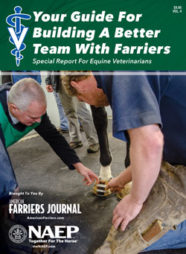The initial signs that acute laminitis is on the horizon may be vague or go unnoticed by the hoof-care client.
There might be a general suspicion that something isn’t right, shifting weight or indefinite soreness. An owner might write it off as the horse being worked too hard that week. Hall of Fame farrier Steve Kraus, head of farrier services and senior lecturer at Cornell University College of Veterinary Medicine, notes that they may not register other slow-developing signs that are red flags for the farrier, such as gaining weight, coat changes or a slight cresty neck.
Respondents from January’s poll also pitched in some early signs to look out for.
“First things I see are changes in the body, namely increased inflammation, especially of the suborbital fossa and a cresty neck,” says Tennessee farrier Hannah Nichols. “I tell clients first and foremost to look out for changes in normal behavior. Normally calm horses become mean or nervous, while other horses become slow and lethargic. As it progresses, horses don’t want to move and will lay down more than normal.”
Asking the owner if there are any issues they didn’t think to mention can help make an earlier determination and avoid waiting for symptoms to progress before taking action.
“Alert the owner and discuss feeding, the equine’s lifestyle and any recent changes,” says January’s poll winner, Idaho farrier Bruce Worman. If there are any behavioral signs of lameness, he says radiographs may be advisable.
There are several red flags that the foot presents that indicate a potential laminitic event. Swelling in the coronary band, increased digital pulses and heat — especially in the forelimbs where most of the weight is distributed — are common signs of inflammation. Abnormal growth rings or lines can signal a fever.
Bruising outlining the coffin bone and stretching of the white line are also clear indicators that something is wrong.
“Some of the white line stretching could be mechanical from a long toe, but you might see some bruising or tearing of the tissue where the laminae are hemorrhaging,” says Kraus. “You may also see a flat sole. A horse’s foot should have a nice arch to it. If the horse is naturally flatfooted, but now this flatfooted horse has some bruising on the tip of the coffin bone, those would all be on my radar.”
When it comes to the condition of the foot, laminitis can manifest itself as excessive heel growth, long toes and thin soles. If the farrier picks up a foot and notices any of these signs or the horse is sore after a trim, it’s likely time to get the veterinarian involved.
Gain more insight reading “Identifying & Addressing Acute Laminitis” in the March 2025 issue of American Farriers Journal.








